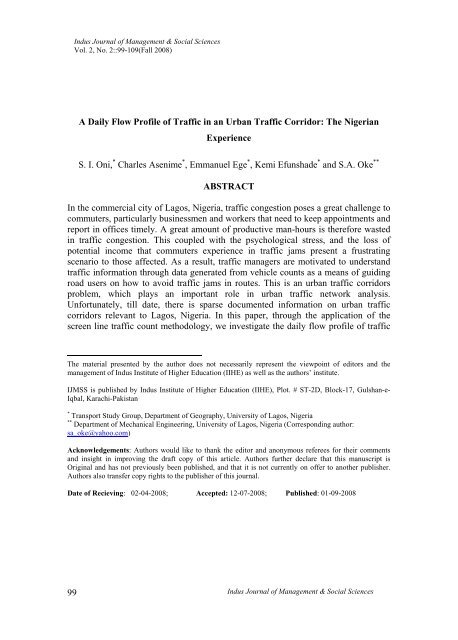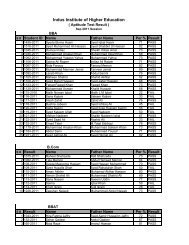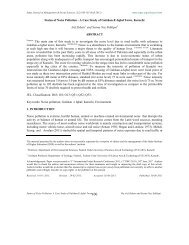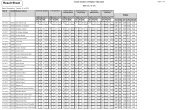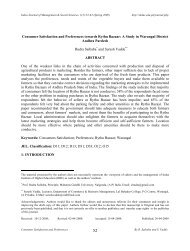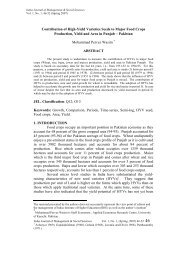2-A Daily Flow Profile of Traffic in an Urban Traffic.pdf
2-A Daily Flow Profile of Traffic in an Urban Traffic.pdf
2-A Daily Flow Profile of Traffic in an Urban Traffic.pdf
You also want an ePaper? Increase the reach of your titles
YUMPU automatically turns print PDFs into web optimized ePapers that Google loves.
Indus Journal <strong>of</strong> M<strong>an</strong>agement<br />
A <strong>Daily</strong> <strong>Flow</strong><br />
&<br />
<strong>Pr<strong>of</strong>ile</strong><br />
Social<br />
<strong>of</strong><br />
Sciences<br />
<strong>Traffic</strong> <strong>in</strong> An Urb<strong>an</strong> <strong>Traffic</strong> Corridor: The Nigeri<strong>an</strong> Experience<br />
Vol. 2, No. 2::99-109(Fall 2008)<br />
A <strong>Daily</strong> <strong>Flow</strong> <strong>Pr<strong>of</strong>ile</strong> <strong>of</strong> <strong>Traffic</strong> <strong>in</strong> <strong>an</strong> Urb<strong>an</strong> <strong>Traffic</strong> Corridor: The Nigeri<strong>an</strong><br />
Experience<br />
S. I. Oni, * Charles Asenime * , Emm<strong>an</strong>uel Ege * , Kemi Efunshade * <strong>an</strong>d S.A. Oke **<br />
ABSTRACT<br />
In the commercial city <strong>of</strong> Lagos, Nigeria, traffic congestion poses a great challenge to<br />
commuters, particularly bus<strong>in</strong>essmen <strong>an</strong>d workers that need to keep appo<strong>in</strong>tments <strong>an</strong>d<br />
report <strong>in</strong> <strong>of</strong>fices timely. A great amount <strong>of</strong> productive m<strong>an</strong>-hours is therefore wasted<br />
<strong>in</strong> traffic congestion. This coupled with the psychological stress, <strong>an</strong>d the loss <strong>of</strong><br />
potential <strong>in</strong>come that commuters experience <strong>in</strong> traffic jams present a frustrat<strong>in</strong>g<br />
scenario to those affected. As a result, traffic m<strong>an</strong>agers are motivated to underst<strong>an</strong>d<br />
traffic <strong>in</strong>formation through data generated from vehicle counts as a me<strong>an</strong>s <strong>of</strong> guid<strong>in</strong>g<br />
road users on how to avoid traffic jams <strong>in</strong> routes. This is <strong>an</strong> urb<strong>an</strong> traffic corridors<br />
problem, which plays <strong>an</strong> import<strong>an</strong>t role <strong>in</strong> urb<strong>an</strong> traffic network <strong>an</strong>alysis.<br />
Unfortunately, till date, there is sparse documented <strong>in</strong>formation on urb<strong>an</strong> traffic<br />
corridors relev<strong>an</strong>t to Lagos, Nigeria. In this paper, through the application <strong>of</strong> the<br />
screen l<strong>in</strong>e traffic count methodology, we <strong>in</strong>vestigate the daily flow pr<strong>of</strong>ile <strong>of</strong> traffic<br />
The material presented by the author does not necessarily represent the viewpo<strong>in</strong>t <strong>of</strong> editors <strong>an</strong>d the<br />
m<strong>an</strong>agement <strong>of</strong> Indus Institute <strong>of</strong> Higher Education (IIHE) as well as the authors’ <strong>in</strong>stitute.<br />
IJMSS is published by Indus Institute <strong>of</strong> Higher Education (IIHE), Plot. # ST-2D, Block-17, Gulsh<strong>an</strong>-e-<br />
Iqbal, Karachi-Pakist<strong>an</strong><br />
* Tr<strong>an</strong>sport Study Group, Department <strong>of</strong> Geography, University <strong>of</strong> Lagos, Nigeria<br />
** Department <strong>of</strong> Mech<strong>an</strong>ical Eng<strong>in</strong>eer<strong>in</strong>g, University <strong>of</strong> Lagos, Nigeria (Correspond<strong>in</strong>g author:<br />
sa_oke@yahoo.com)<br />
Acknowledgements: Authors would like to th<strong>an</strong>k the editor <strong>an</strong>d <strong>an</strong>onymous referees for their comments<br />
<strong>an</strong>d <strong>in</strong>sight <strong>in</strong> improv<strong>in</strong>g the draft copy <strong>of</strong> this article. Authors further declare that this m<strong>an</strong>uscript is<br />
Orig<strong>in</strong>al <strong>an</strong>d has not previously been published, <strong>an</strong>d that it is not currently on <strong>of</strong>fer to <strong>an</strong>other publisher.<br />
Authors also tr<strong>an</strong>sfer copy rights to the publisher <strong>of</strong> this journal.<br />
Date <strong>of</strong> Reciev<strong>in</strong>g: 02-04-2008; Accepted: 12-07-2008; Published: 01-09-2008<br />
99<br />
Indus Journal <strong>of</strong> M<strong>an</strong>agement & Social Sciences
S. I. Oni, Charles Asenime, Emm<strong>an</strong>uel Ege, Kemi Efunshade, S.A. Oke<br />
<strong>in</strong> <strong>an</strong> urb<strong>an</strong> traffic corridor <strong>in</strong> Lagos, which is a commercial nerve centre <strong>of</strong> a<br />
develop<strong>in</strong>g country.<br />
JEL. Classification: D01;D11;H11;H41;H54;J20;J21;J24;L91;O18<br />
KEYWORDS: <strong>Traffic</strong> Count, Urb<strong>an</strong> <strong>Traffic</strong>, <strong>Traffic</strong> Corridor, <strong>Traffic</strong> Network,<br />
<strong>Traffic</strong> Congestion<br />
1. INTRODUCTION<br />
Metropolit<strong>an</strong> Lagos has been described as the sixth fastest grow<strong>in</strong>g city <strong>in</strong> the<br />
develop<strong>in</strong>g world. The city is highly populated with m<strong>an</strong>y problems such as<br />
overcrowd<strong>in</strong>g (high population density), overstretched usage <strong>of</strong> facilities (roads,<br />
schools, <strong>an</strong>d health centers), <strong>in</strong>adequate electricity supply, <strong>an</strong>d high traffic congestion.<br />
As a result <strong>of</strong> these problems m<strong>an</strong>y <strong>in</strong>habit<strong>an</strong>ts <strong>of</strong> Lagos metropolit<strong>an</strong> are const<strong>an</strong>tly<br />
relocat<strong>in</strong>g to previously un<strong>in</strong>habited locations that could guar<strong>an</strong>tee cheaper <strong>an</strong>d better<br />
hous<strong>in</strong>g as well as provide necessary facilities which are hitherto overstretched <strong>in</strong> the<br />
city. Despite the movement <strong>of</strong> people to new locations some <strong>of</strong> these problems that<br />
were avoided by stay<strong>in</strong>g away from the metropolit<strong>an</strong> start evolv<strong>in</strong>g up <strong>in</strong> the new<br />
location. The problem <strong>of</strong> traffic flow is one <strong>of</strong> these import<strong>an</strong>t challenges that need to<br />
be resolved.<br />
For the less congested Iy<strong>an</strong>a Ipaja/Ikotun area <strong>of</strong> the city, the traffic flow has been<br />
challeng<strong>in</strong>g, lead<strong>in</strong>g to m<strong>an</strong>y hours spent <strong>in</strong> traffic jams. The challenge <strong>of</strong><br />
underst<strong>an</strong>d<strong>in</strong>g this traffic situation, with a view <strong>of</strong> pr<strong>of</strong>fer<strong>in</strong>g solution is therefore<br />
tackled <strong>in</strong> the current paper. In particular, traffic counts are taken along the Iy<strong>an</strong>a<br />
Ipaja/Ikotun traffic corridor which experiences very high volume <strong>of</strong> traffic. The<br />
traffic count therefore aims at estimat<strong>in</strong>g traffic flow <strong>an</strong>d its characteristics. Thus, the<br />
study provides <strong>an</strong> <strong>in</strong>sight <strong>of</strong> the type <strong>of</strong> traffic m<strong>an</strong>agement system or tool to be<br />
employed by traffic m<strong>an</strong>agement agencies. This will ensure that traffic flows without<br />
h<strong>in</strong>dr<strong>an</strong>ce. In addition, <strong>in</strong>sights <strong>in</strong>to underst<strong>an</strong>d<strong>in</strong>g how to develop a travel dem<strong>an</strong>d<br />
m<strong>an</strong>agement system would be ga<strong>in</strong>ed.<br />
What follows is a review <strong>of</strong> literature relat<strong>in</strong>g to traffic flow <strong>in</strong> order to identify the<br />
import<strong>an</strong>t gap that the current paper fills. Yu <strong>an</strong>d Shi (2008) proposed <strong>an</strong> extended<br />
traffic flow model by <strong>in</strong>troduc<strong>in</strong>g the relative velocity <strong>of</strong> arbitrary number <strong>of</strong> cars that<br />
precede <strong>an</strong>d that follow <strong>in</strong>to the Newell-Whitham-type car-follow<strong>in</strong>g model. Gu<strong>an</strong><br />
<strong>an</strong>d He (2008) <strong>in</strong>vestigated the velocity-density relationships <strong>of</strong> urb<strong>an</strong> freeways. Hou,<br />
Xu, <strong>an</strong>d Y<strong>an</strong> (2008) applied the iterative learn<strong>in</strong>g control approach to address the<br />
traffic density control problem <strong>in</strong> a macroscopic level freeway environment with<br />
ramp meter<strong>in</strong>g. Baykal-Gursoy, Xiao, <strong>an</strong>d Ozbay (2008) modelled traffic flow<br />
<strong>in</strong>terrupted by <strong>in</strong>cidents. Zhu <strong>an</strong>d Dai (2008) simulated the soliton <strong>an</strong>d k<strong>in</strong>k-<strong>an</strong>tik<strong>in</strong>k<br />
density waves <strong>an</strong>d concluded that the maximal current <strong>of</strong> traffic-flow <strong>in</strong>creases with<br />
decreas<strong>in</strong>g <strong>of</strong> the safety dist<strong>an</strong>ce. Wu, Sun, <strong>an</strong>d Gao (2008) proposed a dynamic<br />
traffic model (DTM) for rout<strong>in</strong>g choice behaviour (RCB) <strong>in</strong> which both topology<br />
Vol.2, No.2:99-109 (Fall 2008) 100
A <strong>Daily</strong> <strong>Flow</strong> <strong>Pr<strong>of</strong>ile</strong> <strong>of</strong> <strong>Traffic</strong> <strong>in</strong> An Urb<strong>an</strong> <strong>Traffic</strong> Corridor: The Nigeri<strong>an</strong> Experience<br />
structures <strong>an</strong>d dynamic properties are considered to address the RCB problem by<br />
us<strong>in</strong>g numerical experiments.<br />
T<strong>an</strong>g, Hu<strong>an</strong>g, Mei <strong>an</strong>d Zhao (2008) <strong>in</strong>troduced a dynamic equation <strong>of</strong> road flow <strong>in</strong>to<br />
each l<strong>in</strong>k, <strong>an</strong>d thereby proposed a dynamic model for network flow. Loggle <strong>an</strong>d<br />
Immers (2008) extended the orig<strong>in</strong>al LWR model to <strong>in</strong>corporate more <strong>an</strong>d realistic<br />
details. Golob, Recker, <strong>an</strong>d Y<strong>an</strong>nis (2007) laid the ground work for gaug<strong>in</strong>g the level<br />
<strong>of</strong> safety <strong>of</strong> <strong>an</strong>y type <strong>of</strong> traffic flow on a freeway, based on data from s<strong>in</strong>gle loop<br />
detectors. Castillo, Menendez <strong>an</strong>d S<strong>an</strong>chez-Cambronero (2007) dealt with the<br />
problem <strong>of</strong> predict<strong>in</strong>g traffic flows <strong>an</strong>d updat<strong>in</strong>g these predictions when <strong>in</strong>formation<br />
about OD pairs <strong>an</strong>d/or l<strong>in</strong>k flows becomes available. Shi, Wu, Li, <strong>an</strong>d Zhong (2007)<br />
researched two-dimensional cellular automation model for traffic flow as it reveals<br />
the ma<strong>in</strong> characteristics <strong>of</strong> the traffic networks <strong>in</strong> cities. Lu, Wong, Zh<strong>an</strong>g, Shu <strong>an</strong>d<br />
Chen (2007) explicitly constructed the entropy solutions for the Lighthill-Whitham<br />
Richards (LWR) traffic flow model with a flow-density relationship, which is<br />
piecewise quadratic, cont<strong>in</strong>uous <strong>an</strong>d concave. Gu<strong>an</strong> <strong>an</strong>d He (2008) <strong>in</strong>vestigated<br />
traffic flow theory by ma<strong>in</strong>ly focus<strong>in</strong>g on highway traffic, which is signific<strong>an</strong>tly<br />
different from urb<strong>an</strong> freeway.<br />
The presented paper has four sections. Their order <strong>of</strong> presentation is (1) <strong>in</strong>troduction,<br />
(2) methodology, (3) results <strong>an</strong>d discussion, <strong>an</strong>d (4) a conclusion. The <strong>in</strong>troduction<br />
builds <strong>an</strong> argument to express the problem <strong>an</strong>d the need to face this challenge. This is<br />
complemented with literature search, which <strong>in</strong>dicates the gap that is yet to be filled.<br />
The methodology section presents <strong>in</strong>formation on the approach utilized <strong>in</strong> solv<strong>in</strong>g the<br />
problem. The results section presents the outcomes <strong>of</strong> the <strong>an</strong>alysis that were obta<strong>in</strong>ed<br />
from <strong>an</strong> effort to practically measure the traffic flow. A discussion, which outl<strong>in</strong>es the<br />
practical <strong>an</strong>d operational elements <strong>of</strong> the study, is also given <strong>in</strong> the section on results.<br />
The last section <strong>of</strong> this paper gives conclud<strong>in</strong>g remarks on the study <strong>an</strong>d its benefits.<br />
2. METHODOLOGY<br />
2.1 City Description<br />
Lagos metropolit<strong>an</strong> <strong>in</strong>corporates 16 <strong>of</strong> the 20 Local Government Areas <strong>of</strong> Lagos<br />
State. For now, there is no <strong>of</strong>ficial boundary as metropolit<strong>an</strong> Lagos because <strong>of</strong> its<br />
rapid exp<strong>an</strong>sion <strong>in</strong>to areas which hitherto seems un<strong>in</strong>habited. However for the<br />
purpose <strong>of</strong> this paper, the boundaries <strong>of</strong> Lagos metropolis to consist <strong>of</strong> the territory<br />
situated with<strong>in</strong> Latitudes 6 0 23’ N <strong>an</strong>d 6 0 41’ N <strong>an</strong>d Longitudes 3 0 09’ E <strong>an</strong>d 3 0 28’E.<br />
This area is bounded <strong>in</strong> the East by the stretch <strong>of</strong> the Lagos Lagoon <strong>an</strong>d <strong>in</strong> the South<br />
by the Atl<strong>an</strong>tic Oce<strong>an</strong>. Of the total l<strong>an</strong>d mass <strong>of</strong> 3,577sqkm occupied by Lagos State,<br />
metropolit<strong>an</strong> Lagos extends over <strong>an</strong> area <strong>of</strong> 1,140sqkm which consists one third <strong>of</strong> the<br />
L<strong>an</strong>d mass. Figure 1 shows Metropolit<strong>an</strong> Lagos.<br />
The current National Population Commission (NPC) estimated the states population<br />
at 9.1 million people. Various estimates however puts it at between 12.8 <strong>an</strong>d 15.0<br />
million <strong>of</strong> which Lagos metropolis alone is estimated to have a population <strong>of</strong> 12<br />
101<br />
Indus Journal <strong>of</strong> M<strong>an</strong>agement & Social Sciences
S. I. Oni, Charles Asenime, Emm<strong>an</strong>uel Ege, Kemi Efunshade, S.A. Oke<br />
million people <strong>an</strong>d a density <strong>of</strong> 1,300 persons per square kilometer. This is 15 times<br />
more th<strong>an</strong> the national average. It is also expected that growth will cont<strong>in</strong>ue at the<br />
current rate <strong>of</strong> nearly 6% per <strong>an</strong>num. This phenomenal <strong>in</strong>crease <strong>in</strong> population is due<br />
to its position as a melt<strong>in</strong>g pot <strong>of</strong> bus<strong>in</strong>ess, economic <strong>an</strong>d social activities. Of all the<br />
urb<strong>an</strong> centers <strong>in</strong> Nigeria, Metro-Lagos has played the most signific<strong>an</strong>t role <strong>in</strong> the<br />
wholesale absorption <strong>of</strong> rural population. The l<strong>an</strong>d use pattern <strong>of</strong> the metropolis is<br />
skewed. The over concentration <strong>of</strong> urb<strong>an</strong>/commercial activities along the North-<br />
South corridor <strong>of</strong> the metropolis <strong>an</strong>d the agglomeration <strong>an</strong>d <strong>in</strong>creased separation <strong>of</strong><br />
residencies to work place has created a need for daily journey to work on a large scale<br />
which has <strong>in</strong>fluenced traffic flow pattern that is structured towards the north-south<br />
direction dur<strong>in</strong>g the morn<strong>in</strong>gs <strong>an</strong>d reverses <strong>in</strong> the even<strong>in</strong>gs.<br />
Figure 1. Map <strong>of</strong> Study Area<br />
Vol.2, No.2:99-109 (Fall 2008) 102
A <strong>Daily</strong> <strong>Flow</strong> <strong>Pr<strong>of</strong>ile</strong> <strong>of</strong> <strong>Traffic</strong> <strong>in</strong> An Urb<strong>an</strong> <strong>Traffic</strong> Corridor: The Nigeri<strong>an</strong> Experience<br />
Lagos Metropolis c<strong>an</strong> be aptly described as the most heavily motorized part <strong>of</strong><br />
Nigeria, currently almost all movements are made by road, while water <strong>an</strong>d rail<br />
accounts for about 1%.<br />
2.2 The Studied Road<br />
The Iy<strong>an</strong>a-Ikotun road is a dual carriage ten-kilometer road located <strong>in</strong> Alimoshho<br />
Local government area, which is reputed as the largest <strong>in</strong> terms <strong>of</strong> population size by<br />
current population estimates from the National Population Commission. This<br />
accounts for why the State government is <strong>in</strong>terested <strong>in</strong> establish<strong>in</strong>g a pilot bus<br />
fr<strong>an</strong>chise scheme to meet the mobility needs <strong>of</strong> its teem<strong>in</strong>g population. The corridor is<br />
ma<strong>in</strong>ly <strong>of</strong> low residential with pockets <strong>of</strong> medium <strong>in</strong>come settlements. Its l<strong>an</strong>d use<br />
pattern <strong>in</strong>volves commercial activities l<strong>in</strong><strong>in</strong>g the full stretch <strong>of</strong> the road, with markets<br />
at Isheri junction, Egbeda Junction, Ikotun rounabout <strong>an</strong>d Iy<strong>an</strong>a Ipaja. The road acts<br />
as a major l<strong>in</strong>k to traffic go<strong>in</strong>g to the Badagry express way, Isolo (that serves as a<br />
thoroughfare to the CBD <strong>of</strong> Lagos Isl<strong>an</strong>d, Ikoyi <strong>an</strong>d Victoria Isl<strong>an</strong>d) <strong>an</strong>d various<br />
access roads l<strong>in</strong>k<strong>in</strong>g it.<br />
2.3 Screen L<strong>in</strong>e <strong>Traffic</strong> Counts Methodology<br />
Step 1: Screen L<strong>in</strong>e Identification<br />
Six count<strong>in</strong>g stations were selected which <strong>in</strong>clude: SL1 Moshalashi, SL2 Egbeda,<br />
SL3 Isheri, SL4 Idimu, SL5 Council <strong>an</strong>d SL6 College junctions. These screen l<strong>in</strong>es<br />
were used to calibrate the traffic flow pattern. The screen l<strong>in</strong>es were selected after<br />
audit<strong>in</strong>g the road <strong>an</strong>d identify<strong>in</strong>g junctions were traffic leakages could occur. Screen<br />
l<strong>in</strong>es were placed <strong>in</strong> between these major leakages to fully capture the traffic flow.<br />
The screen l<strong>in</strong>es were arr<strong>an</strong>ged <strong>in</strong> such ways that if the total figures for each screen<br />
l<strong>in</strong>es are collated it will give the total traffic flow on the road.<br />
Step 2: Deployment <strong>of</strong> Personnel<br />
The results <strong>of</strong> the <strong>in</strong>vestigation earlier carried out, assisted <strong>in</strong> allocat<strong>in</strong>g traffic count<br />
personnel to each screen l<strong>in</strong>e. Each screen l<strong>in</strong>e has its own characteristics while some<br />
screen l<strong>in</strong>es may have more <strong>of</strong> a particular vehicular type others may have less. This<br />
expla<strong>in</strong>s why some personnel were allocated to count more th<strong>an</strong> one vehicular type.<br />
Therefore, the characteristics <strong>of</strong> the vehicular flow types, will determ<strong>in</strong>e how m<strong>an</strong>y<br />
traffic count personnel will be <strong>in</strong> a particular station.<br />
Step 3: Count Duration <strong>an</strong>d Configuration<br />
The count is a 17 th hour count between 6am <strong>an</strong>d 11pm on both sides <strong>of</strong> the road. Two<br />
teams (morn<strong>in</strong>g <strong>an</strong>d afternoon) work<strong>in</strong>g <strong>in</strong> two shifts (morn<strong>in</strong>g shift 6am-2pm <strong>an</strong>d<br />
even<strong>in</strong>g shift 2pm-11pm) which amounted to a total <strong>of</strong> 96 personnel that the<br />
conducted m<strong>an</strong>ual counts on each screen with record<strong>in</strong>g done on hourly basis for 4<br />
103<br />
Indus Journal <strong>of</strong> M<strong>an</strong>agement & Social Sciences
S. I. Oni, Charles Asenime, Emm<strong>an</strong>uel Ege, Kemi Efunshade, S.A. Oke<br />
days which amounted to a total <strong>of</strong> 68 hours. The days <strong>of</strong> count<strong>in</strong>g are Monday,<br />
Wednesday, Friday <strong>an</strong>d Sunday. Monday was chosen s<strong>in</strong>ce it is the first work<strong>in</strong>g day<br />
<strong>of</strong> the week, Wednesday represents mid week count, Friday represents the last <strong>of</strong>ficial<br />
work<strong>in</strong>g day, while Sunday represents counts <strong>of</strong> a typical <strong>of</strong>f work day. Two<br />
supervisors were assigned to monitor the personnel on the field to ensure compli<strong>an</strong>ce<br />
by field personnel. The vehicular type were categorised <strong>in</strong> the follow<strong>in</strong>g as: M<strong>in</strong>i<br />
buses pa<strong>in</strong>ted, M<strong>in</strong>i buses unpa<strong>in</strong>ted, Cars, Taxis, Molue (Large Buses), <strong>an</strong>d Heavy<br />
Duty Vehicles (HDV)<br />
Step 4: <strong>Traffic</strong> <strong>Flow</strong> Characteristics <strong>in</strong> Iy<strong>an</strong>a-Ipaja/Ikotun Road<br />
M<strong>an</strong>ual traffic counts are <strong>an</strong>alysed to determ<strong>in</strong>e the basic traffic flow characteristics<br />
<strong>of</strong> the road.<br />
3. RESULTS AND DISCUSSION<br />
Table 1 is a summary <strong>of</strong> the count. The complete tables are attached as appendix<br />
Table 1: 2-way traffic count summaries <strong>of</strong> Iy<strong>an</strong>a-Ipaja/Ikotun Road<br />
SCREEN LINES<br />
SL1 SL2 SL3 SL4 SL5 SL6<br />
Days Direction Moshalashi Egbeda Isheri Idimu Council College<br />
IYP-IK 15111 12398 11769 9533 9007 6650<br />
Day1 (Mon) IK-IYP 16807 11344 14337 11056 10037 7967<br />
Day2 IYP-IK 11605 13800 12697 10184 8698 6560<br />
(Wed) IK-IYP 16756 11458 10819 10840 10100 7813<br />
Day3 IYP-IK 11577 12026 12510 9286 8433 6452<br />
(Fri) IK-IYP 10903 9468 8103 11029 9226 7531<br />
Day4 IYP-IK 11448 13233 9856 9249 9077 6583<br />
(Sun) IK-IYP 16664 10403 11981 11230 9957 7354<br />
Total 110871 94130 92072 82407 74535 56910<br />
Legend: IYP (Iy<strong>an</strong>a-Ipaja), IK (Ikotun), SL (Screen L<strong>in</strong>e)<br />
The counts reveal that the daily flow pr<strong>of</strong>ile varies throughout the week from Iy<strong>an</strong>a-<br />
Ipaja to Ikotun <strong>an</strong>d it is largely repeated on the opposite direction, but with a higher<br />
flow on Monday at all the screen l<strong>in</strong>es. This may not be a surprise, s<strong>in</strong>ce Monday<br />
be<strong>in</strong>g the first work<strong>in</strong>g day <strong>of</strong> the week is usually characterised by high activity.<br />
Figure 2 is the traffic daily flow pr<strong>of</strong>ile from Iy<strong>an</strong>a-Ipaja to Ikotun, while Figure 3 is<br />
the flow from Ikotun to Iy<strong>an</strong>a-Ipaja.<br />
Further <strong>an</strong>alysis <strong>of</strong> Figure 2 reveals that traffic flow on the selected days decreases as<br />
the weekend approaches; this does not imply that people don’t go to work. Rather it<br />
reflects the tendency that exists whereby <strong>of</strong>fice workers try to bit the traffic situation<br />
<strong>in</strong> the metropolis by sleep<strong>in</strong>g <strong>in</strong> their places <strong>of</strong> work or with a friend <strong>an</strong>d com<strong>in</strong>g back<br />
Vol.2, No.2:99-109 (Fall 2008) 104
A <strong>Daily</strong> <strong>Flow</strong> <strong>Pr<strong>of</strong>ile</strong> <strong>of</strong> <strong>Traffic</strong> <strong>in</strong> An Urb<strong>an</strong> <strong>Traffic</strong> Corridor: The Nigeri<strong>an</strong> Experience<br />
home on Fridays. SL2 Egbeda is slightly different with Day 2 figures higher th<strong>an</strong><br />
other screen l<strong>in</strong>es, because Egbeda is a major exit po<strong>in</strong>t to the CBD.<br />
On the reverse side, movement towards Iy<strong>an</strong>a-Ipaja is lower, the low traffic was<br />
recorded <strong>in</strong> the even<strong>in</strong>gs as only few people move towards Iy<strong>an</strong>aipaja at that period,<br />
workers are already on their way home, <strong>an</strong>d a larger part <strong>of</strong> the population live<br />
towards the Ikotun end <strong>of</strong> the road, however Egbeda SL2 on day 2 shows a<br />
remarkable drop <strong>in</strong> relation to other screen l<strong>in</strong>es due to the fact that it is used mostly<br />
as <strong>an</strong> exit po<strong>in</strong>t (Figure 4). Return<strong>in</strong>g workers enter the road through Iy<strong>an</strong>a-Ipaja.<br />
16000<br />
14000<br />
12000<br />
10000<br />
<strong>Traffic</strong> volume<br />
8000<br />
6000<br />
4000<br />
2000<br />
0<br />
MOSHALASHI EGBEDA ISHERI IDIMU COUNCIL COLLEGE<br />
SL1 SL2 SL3 SL4 SL5 SL6<br />
Screen L<strong>in</strong>es<br />
DAY1 DAY2 DAY3 DAY4<br />
Figure 2. <strong>Traffic</strong> <strong>Daily</strong> flow pr<strong>of</strong>ile from Iy<strong>an</strong>a-Ipaja to Ikotun<br />
105<br />
Indus Journal <strong>of</strong> M<strong>an</strong>agement & Social Sciences
S. I. Oni, Charles Asenime, Emm<strong>an</strong>uel Ege, Kemi Efunshade, S.A. Oke<br />
18000<br />
16000<br />
14000<br />
12000<br />
10000<br />
8000<br />
6000<br />
4000<br />
2000<br />
0<br />
MOSHALASHI EGBEDA ISHERI IDIMU COUNCIL COLLEGE<br />
SL1 SL2 SL3 SL4 SL5 SL6<br />
DAY1 DAY2 DAY3 DAY4<br />
4. CONCLUSION<br />
Figure 3. <strong>Traffic</strong> <strong>Daily</strong> flow pr<strong>of</strong>ile from Ikotun to Iy<strong>an</strong>a-Ipaja<br />
The need for cheaper <strong>an</strong>d better hous<strong>in</strong>g has forced m<strong>an</strong>y people to seek<br />
accommodation further away from the CBD <strong>in</strong> the South-East traffic corridor <strong>of</strong> the<br />
metropolis. This phenomenon has its own implication on mobility, especially on the<br />
Iy<strong>an</strong>a-Ipaja/Ikotun traffic corridor which is experienc<strong>in</strong>g very high volume <strong>of</strong> traffic.<br />
Current population estimate by the National Population Commission (NPC) puts the<br />
population <strong>in</strong> excess <strong>of</strong> one million. It is not surpris<strong>in</strong>g then for the Word B<strong>an</strong>k <strong>an</strong>d<br />
the state government to be <strong>in</strong>terested <strong>in</strong> establish<strong>in</strong>g a pilot bus fr<strong>an</strong>chise scheme. The<br />
traffic count therefore is aimed at estimat<strong>in</strong>g traffic flow <strong>an</strong>d its characteristics; the<br />
study gives <strong>an</strong> <strong>in</strong>sight <strong>of</strong> the type <strong>of</strong> traffic m<strong>an</strong>agement system or tool to be<br />
employed by traffic m<strong>an</strong>agement agencies ensur<strong>in</strong>g that traffic flows without<br />
h<strong>in</strong>dr<strong>an</strong>ce <strong>an</strong>d how to further develop a travel dem<strong>an</strong>d m<strong>an</strong>agement system that will<br />
be beneficial to all.<br />
REFERENCES<br />
Baykal-Gursoy, M. W. Xiao, <strong>an</strong>d K. Ozbay. 2008. Model<strong>in</strong>g <strong>Traffic</strong> <strong>Flow</strong> by<br />
Incidents. Europe<strong>an</strong> Journal <strong>of</strong> Operational Research. Available at:<br />
sciencedirect.com.<br />
Castillo, E., Menendez <strong>an</strong>d S. S<strong>an</strong>chez-Cambronero. 2007, Predict<strong>in</strong>g <strong>Traffic</strong> <strong>Flow</strong><br />
Us<strong>in</strong>g Bayesi<strong>an</strong> Networks. Tr<strong>an</strong>sportation Research Part B:<br />
Methodological. Available at: sciencedirect.com.<br />
Vol.2, No.2:99-109 (Fall 2008) 106
A <strong>Daily</strong> <strong>Flow</strong> <strong>Pr<strong>of</strong>ile</strong> <strong>of</strong> <strong>Traffic</strong> <strong>in</strong> An Urb<strong>an</strong> <strong>Traffic</strong> Corridor: The Nigeri<strong>an</strong> Experience<br />
Gu<strong>an</strong>, W. <strong>an</strong>d S. He. 2008. Statistical Features <strong>of</strong> <strong>Traffic</strong> <strong>Flow</strong> on Urb<strong>an</strong> Freeways.<br />
Physica A: Statistical Mech<strong>an</strong>ics <strong>an</strong>d its Applications, 387(4): 944-954.<br />
Golob, T.F., W. Recker <strong>an</strong>d Pavhs Y<strong>an</strong>nis. 2007. Probabilistic Models <strong>of</strong> Freeway<br />
Safety Perform<strong>an</strong>ce Us<strong>in</strong>g <strong>Traffic</strong> <strong>Flow</strong> Data as Predictors. Safety Science. Available<br />
at:sciencedirect.com.<br />
Hou, Z., J. Xu, J. Y<strong>an</strong>. 2008. An Iterative Learn<strong>in</strong>g Approach to Density Control <strong>of</strong><br />
Freeway <strong>Traffic</strong> <strong>Flow</strong> via Ramp Meter<strong>in</strong>g. Tr<strong>an</strong>sportation Research Part C:<br />
Emerg<strong>in</strong>g Technologies, 16(1): 71-97.<br />
Logghe, S. <strong>an</strong>d L.H. Immers. 2008. Multi-Class K<strong>in</strong>ematic Wave Theory <strong>of</strong> <strong>Traffic</strong><br />
<strong>Flow</strong>. Tr<strong>an</strong>sportation Research Part B: Methodological. Available at:<br />
sciencedirect.com.<br />
Lu, Y., S.C. Wong, M. Zh<strong>an</strong>g, C-W. Shu <strong>an</strong>d W. Chen. 2007. Explicit Construction<br />
<strong>of</strong> Entropy Solutions for the Lighthill-Witham-Richard’s <strong>Traffic</strong> <strong>Flow</strong> Model<br />
with A Piecewise Quadratic <strong>Flow</strong>-Density Relationship. Tr<strong>an</strong>sportation<br />
Research Part B: Methodological. Available at: sciencedirect.com.<br />
Shi, X-Q, Y-Q Wu, H. Li <strong>an</strong>d R. Zhong. 2007. Second Order Phase Tr<strong>an</strong>sition <strong>in</strong><br />
Two-Dimensional Cellular Automation Model <strong>of</strong> <strong>Traffic</strong> <strong>Flow</strong> Conta<strong>in</strong><strong>in</strong>g<br />
Road Sections. Physica A: Statistical Mech<strong>an</strong>ics <strong>an</strong>d its Applications,<br />
385(2): 659-666.<br />
T<strong>an</strong>g, T.Q., H.J. Hu<strong>an</strong>g, C.Q. Mei <strong>an</strong>d S.G. Zhao. 2008. A Dynamic Model for<br />
<strong>Traffic</strong> Network <strong>Flow</strong>. Physica A: Statistical Mech<strong>an</strong>ics <strong>an</strong>d its<br />
Applications. Available at: sciencedirect.com.<br />
Wu, J.J., H.J. Sun, <strong>an</strong>d Z.Y. Gao. 2008. Dynamic Urb<strong>an</strong> <strong>Traffic</strong> <strong>Flow</strong> Behaviour on<br />
Scale-Free Networks. Physica A: Statistical Mech<strong>an</strong>ics <strong>an</strong>d its Applications,<br />
387(2-3): 653-660.<br />
Yu, L. <strong>an</strong>d Z. Shi. 2008. Non-L<strong>in</strong>ear Analysis <strong>of</strong> <strong>an</strong> Extended <strong>Traffic</strong> <strong>Flow</strong> Model <strong>in</strong><br />
ITS Environment. Chaos, Solitons <strong>an</strong>d Fractals, 36(3): 550-558.<br />
Zhu, H.B <strong>an</strong>d S.Q. Dai. 2008. Numerical Simulation <strong>of</strong> Solitons <strong>an</strong>d K<strong>in</strong>k Density<br />
Waves <strong>in</strong> <strong>Traffic</strong> <strong>Flow</strong> with Periodic Boundaries. Physica A: Statistical<br />
Mech<strong>an</strong>ics <strong>an</strong>d its Applications. Available at: sciencedirect.com.<br />
107<br />
Indus Journal <strong>of</strong> M<strong>an</strong>agement & Social Sciences
S. I. Oni, Charles Asenime, Emm<strong>an</strong>uel Ege, Kemi Efunshade, S.A. Oke<br />
Appendix (Table A1:<strong>Traffic</strong> count summaries)<br />
IYP-IK<br />
MOSHALASHI<br />
ISHERI<br />
V/TYPE Day1 Day2 Day3 Day4 V/TYPE Day1 Day2 Day3 Day4<br />
MBP 7507 5527 5828 5536 MBP 4822 4952 5402 4960<br />
MBUP 1719 1667 1285 1097 MBUP 1055 1012 1020 859<br />
CARS 5082 3550 3691 4147 CARS 5292 6161 5402 3644<br />
TAXIS 123 304 108 179 TAXIS 127 208 111 88<br />
MOLUE 52 30 42 35 MOLUE 23 31 13 2<br />
HDV 628 527 623 454 HDV 450 333 562 303<br />
TOTAL 15111 11605 11577 11448 TOTAL 11769 12697 12510 9856<br />
EGBEDA<br />
V/TYPE Day1 Day2 Day3 Day4 IDIMU<br />
MBP 5400 5827 5132 5643 V/TYPE Day1 Day2 Day3 Day4<br />
MBUP 1177 1392 1298 1658 MBP 4617 4942 4171 4687<br />
CARS 5275 5818 4974 5283 MBUP 539 498 648 614<br />
TAXIS 139 188 146 177 CARS 4008 4374 4111 3647<br />
MOLUE 27 39 24 26 TAXIS 66 72 82 76<br />
HDV 380 536 452 446 MOLUE 9 12 8 11<br />
TOTAL 12398 13800 12026 13233 HDV 294 286 266 214<br />
TOTAL 9533 10184 9286 9249<br />
COUNCIL<br />
COLLEGE<br />
V/TYPE Day1 Day2 Day3 Day4 V/TYPE Day1 Day2 Day3 Day4<br />
MBP 4445 4767 4212 4613 MBP 4219 4413 4149 4437<br />
MBUP 616 473 595 581 MBUP 490 348 389 372<br />
CARS 3655 3239 3016 3536 CARS 1800 1657 1730 1602<br />
TAXIS 60 60 174 47 TAXIS 35 9 31 21<br />
MOLUE 36 15 30 34 MOLUE 14 21 20 36<br />
HDV 195 144 406 266 HDV 92 112 133 115<br />
TOTAL 9007 8698 8433 9077 TOTAL 6650 6560 6452 6583<br />
Vol.2, No.2:99-109 (Fall 2008) 108
A <strong>Daily</strong> <strong>Flow</strong> <strong>Pr<strong>of</strong>ile</strong> <strong>of</strong> <strong>Traffic</strong> <strong>in</strong> An Urb<strong>an</strong> <strong>Traffic</strong> Corridor: The Nigeri<strong>an</strong> Experience<br />
IK-IP<br />
MOSHALASHI<br />
EGBEDA<br />
V/TYPE Day1 Day2 Day3 Day4 V/TYPE Day1 Day2 Day3 Day4<br />
MBP 7826 7253 4650 7411 MBP 5197 5564 4596 4760<br />
MBUP 1480 1526 910 1312 MBUP 1614 1395 838 1323<br />
CARS 6583 7174 4851 7153 CARS 3987 3900 3540 3700<br />
TAXIS 165 174 153 195 TAXIS 57 80 88 115<br />
MOLUE 59 45 34 43 MOLUE 4 19 3 17<br />
HDV 694 584 305 550 HDV 485 500 403 488<br />
TOTAL 16807 16756 10903 16664 TOTAL 11344 11458 9468 10403<br />
ISHERI<br />
IDIMU<br />
V/TYPE Day1 Day2 Day3 Day4 V/TYPE Day1 Day2 Day3 Day4<br />
MBP 5197 4810 3779 3850 MBP 4752 4156 4057 4010<br />
MBUP 1438 799 894 994 MBUP 773 759 759 690<br />
CARS 6920 4552 3035 6290 CARS 4793 5218 5492 5693<br />
TAXIS 327 98 91 217 TAXIS 105 95 143 132<br />
MOLUE 20 24 7 22 MOLUE 14 20 30 18<br />
HDV 435 536 297 608 HDV 619 592 548 687<br />
TOTAL 14337 10819 8103 11981 TOTAL 11056 10840 11029 11230<br />
COUNCIL<br />
COLLEGE<br />
V/TYPE Day1 Day2 Day3 Day4 V/TYPE Day1 Day2 Day3 Day4<br />
MBP 4374 4182 4218 4115 MBP 4374 3978 4154 3662<br />
MBUP 596 622 559 597 MBUP 472 457 468 426<br />
CARS 4452 4891 3972 4741 CARS 2747 2978 2543 2837<br />
TAXIS 93 86 87 107 TAXIS 57 53 65 62<br />
MOLUE 13 29 14 14 MOLUE 13 10 28 12<br />
HDV 509 290 376 383 HDV 304 337 273 355<br />
TOTAL 10037 10100 9226 9957 TOTAL 7967 7813 7531 7354<br />
Source: Primary data compiled by authors dur<strong>in</strong>g the study <strong>in</strong> the year 2007.<br />
****<br />
109<br />
Indus Journal <strong>of</strong> M<strong>an</strong>agement & Social Sciences


